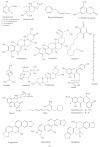Medicinal plants used as antitumor agents in Brazil: an ethnobotanical approach
- PMID: 21528006
- PMCID: PMC3082129
- DOI: 10.1155/2011/365359
Medicinal plants used as antitumor agents in Brazil: an ethnobotanical approach
Abstract
WE DESCRIBE THE MEDICINAL PLANTS THAT HAVE BEEN REPORTED TO BE ANTITUMOR AGENTS AND THAT HAVE BEEN USED IN ETHNOBOTANIC RESEARCH IN BRAZIL TO ANSWER THE FOLLOWING QUESTIONS: what is the abundance of plants reported to be antitumor in Brazil? Have the plant species used for tumor treatment in traditional Brazilian medicine been sufficiently examined scientifically? Our analysis included papers published between 1980 and 2008. A total of 84 medicinal plant species were reported to be used for cancer and tumor prevention or treatment; 69.05% of these were cited as being used for the treatment of tumors and cancer in general and 30.95% for specific tumors or cancers. The plants that were cited at a higher frequency were Aloe vera, Euphorbia tirucalli, and Tabebuia impetiginosa. At least, one pharmacological study was found for 35.71% of the species. Majority of the studies selected were conducted in rural communities and urban areas and in areas with traditional healers in Brazil. We found the following molecules to be the most studied in vitro and in vivo: silibinin, β-lapachone, plumbagin and capsaicin. The species addressed here constitute interesting objects for future studies to various professionals in the field of natural products.
Figures




Similar articles
-
Ethnobotanical study of medicinal plants by population of Valley of Juruena Region, Legal Amazon, Mato Grosso, Brazil.J Ethnopharmacol. 2015 Sep 15;173:383-423. doi: 10.1016/j.jep.2015.07.025. Epub 2015 Jul 30. J Ethnopharmacol. 2015. PMID: 26234177
-
Medicinal plants in Brazil: Pharmacological studies, drug discovery, challenges and perspectives.Pharmacol Res. 2016 Oct;112:4-29. doi: 10.1016/j.phrs.2016.01.021. Epub 2016 Jan 23. Pharmacol Res. 2016. PMID: 26812486 Review.
-
Ethnobotanical study of medicinal plants used by Ribeirinhos in the North Araguaia microregion, Mato Grosso, Brazil.J Ethnopharmacol. 2017 Jun 9;205:69-102. doi: 10.1016/j.jep.2017.04.023. Epub 2017 May 2. J Ethnopharmacol. 2017. PMID: 28476677
-
Traditional Plants Used in Southern Brazil as a Source to Wound Healing Therapies.Chem Biodivers. 2023 Feb;20(2):e202201021. doi: 10.1002/cbdv.202201021. Epub 2023 Jan 26. Chem Biodivers. 2023. PMID: 36703603 Review.
-
Red Lapacho (Tabebuia impetiginosa)--a global ethnopharmacological commodity?J Ethnopharmacol. 2009 Jan 12;121(1):1-13. doi: 10.1016/j.jep.2008.10.004. Epub 2008 Nov 1. J Ethnopharmacol. 2009. PMID: 18992801 Review.
Cited by
-
Biologically based therapies are commonly self-prescribed by Brazilian women for the treatment of advanced breast cancer or its symptoms.Support Care Cancer. 2014 May;22(5):1303-11. doi: 10.1007/s00520-013-2087-x. Epub 2013 Dec 17. Support Care Cancer. 2014. PMID: 24337764
-
Peppers: A "Hot" Natural Source for Antitumor Compounds.Molecules. 2021 Mar 10;26(6):1521. doi: 10.3390/molecules26061521. Molecules. 2021. PMID: 33802144 Free PMC article. Review.
-
The fodder grass resources for ruminants: A indigenous treasure of local communities of Thal desert Punjab, Pakistan.PLoS One. 2020 Mar 5;15(3):e0224061. doi: 10.1371/journal.pone.0224061. eCollection 2020. PLoS One. 2020. PMID: 32134935 Free PMC article.
-
Protective effects of ascorbic acid against anticancer drug-induced oxidative stress and genotoxic damage in Saccharomyces cerevisiae.3 Biotech. 2025 May;15(5):118. doi: 10.1007/s13205-025-04280-y. Epub 2025 Apr 7. 3 Biotech. 2025. PMID: 40206055
-
Anacardic acid (6-pentadecylsalicylic acid) induces apoptosis of prostate cancer cells through inhibition of androgen receptor and activation of p53 signaling.Chin J Cancer Res. 2012 Dec;24(4):275-83. doi: 10.3978/j.issn.1000-9604.2012.10.07. Chin J Cancer Res. 2012. PMID: 23359208 Free PMC article.
References
-
- BRASIL. Ministério da Saúde. Estimativa 2010: Incidência de Câncer no Brasil. Rio de Janeiro, Brazil: Instituto Nacional do Câncer; 2009.
-
- De Almeida VL, Leitão A, Reina LCB, Montanari CA, Donnici CL, Lopes MTP. Cancer e agentes antineoplásicos específicos e ciclo-celular não específicos que interagem com o DNA: uma introdução. Quimica Nova. 2005;28(1):118–129.
-
- Santos MAC, Elisabetsky E. Ethnopharmacology as a tool for the selection of medicinal plants for screening antitumour activity. Revista Brasileira de Plantas Medicinais. 1999;2(1):7–17.
-
- De Oliveira RB, Alves RJ. Agentes antineoplásicos biorredutíveis: uma nova alternativa para o tratamento de tumores sólidos. Quimica Nova. 2002;25(6 A):976–984.
LinkOut - more resources
Full Text Sources

